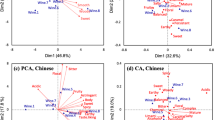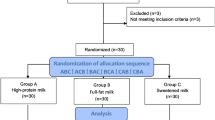Abstract
Based on recent studies in adult subjects, saliva composition is increasingly considered as a physiological factor contributing to taste sensitivity or acceptance. In order to evaluate a possible link between salivary protein composition and taste acceptance in infants, 73 infants participated longitudinally in taste acceptance tests and donated saliva at the age at 3 and 6 months. Intake ratios, reflecting acceptance of a taste solution relative to water were calculated for the five basic tastes. Salivary proteins were separated by one-dimensional electrophoresis and bands were semi-quantified by image analysis. Partial least square (PLS) regression analyses were performed for each taste at both ages to explain intake ratios by band intensities. Bitterness acceptance in the younger infants was unique in the sense that salivary protein profiles could partly predict bitter taste acceptance. At that age, infants were on average indifferent to the 0.18-M urea solution, but great variability in acceptance was observed. The six bands considered as the best predictors for bitterness acceptance were identified by MALDI-TOF mass spectrometry. Higher abundance of bands containing secretory component, zinc-α-2-glycoprotein and carbonic anhydrase 6 was associated to a lower bitterness acceptance, while higher abundance of bands containing lactoperoxidase, prolactin-inducible protein and S-type cystatins was associated to a higher bitterness acceptance. In a second stage, S-type cystatin abundance was measured by Western blotting in order to tentatively confirm this particular finding in an independent group of 22 infants. Although not reaching statistical significance, probably due to a relatively small sample size, it was again observed that cystatin abundance was higher in infants accepting more readily the bitter solution over water. Conclusion: saliva protein composition may contribute to bitter taste acceptance in the younger infants.



Similar content being viewed by others

References
Beauchamp GK, Moran M (1982) Dietary experience and sweet taste preference in human infants. Appetite 3:139–152
Cabras T, Melis M, Castagnola M, Padiglia A, Tepper BJ, Messana I, Tomassini Barbarossa I (2012) Responsiveness to 6-n-propylthiouracil (PROP) is associated with salivary levels of two specific basic proline-rich proteins in humans. PLoS ONE 7:e30962
Candiano G, Bruschi M, Musante L, Santucci L, Ghiggeri GM, Carnemolla B, Orecchia P, Zardi L, Righetti PG (2004) Blue silver: a very sensitive colloidal Coomassie G-250 staining for proteome analysis. Electrophoresis 25:1327–1333
Castagnola M, Inzitari R, Fanali C, Iavarone F, Vitali A, Desiderio C, Vento G, Tirone C, Romagnoli C, Cabras T, Manconi B, Sanna MT, Boi R, Pisano E, Olianas A, Pellegrini M, Nemolato S, Heizmann CW, Faa G, Messana I (2011) The surprising composition of the salivary proteome of preterm human newborn. Mol Cell Proteomics 10
de Moura SAB, de Sousa JMA, Lima DF, Negreiros AND, Silva FD, da Costa LJ (2007) Burning mouth syndrome (BMS): sialometric and sialochemical analysis and salivary protein profile. Gerodontology 24:173–176
Deckelbaum RJ, Williams CL (2001) Childhood obesity: the health issue. Obes Res 9:239S–243S
Desor JA, Maller O, Andrews K (1975) Ingestive responses of human newborns to salty, sour, and bitter stimuli. Journal of Comparative and Physiological Psychology 89:966–970
Dickinson DP (2002) Salivary (SD-type) cystatins: over one billion years in the making-but to what purpose? Critical Reviews in Oral Biology & Medicine 13:485–508
Dsamou M, Palicki O, Septier C, Chabanet C, Lucchi G, Ducoroy P, Chagnon MC, Morzel M (2012) Salivary protein profiles and sensitivity to the bitter taste of caffeine. Chem Senses 37:87–95
Gothefors L, Marklund S (1975) Lactoperoxidase activity in human milk and in saliva of newborn infants. Infect Immun 11:1210–1215
Hassan MI, Waheed A, Yadav S, Singh TP, Ahmad F (2008) Zinc alpha 2-glycoprotein: a multidisciplinary protein. Mol Cancer Res 6:892–906
Henkin RI, Martin BM, Agarwal RP (1999) Decreased parotid saliva gustin/carbonic anhydrase VI secretion: an enzyme disorder manifested by gustatory and olfactory dysfunction. Am J Med Sci 318:380–391
Henkin RI, Martin BM, Agarwal RP (1999) Efficacy of exogenous oral zinc in treatment of patients with carbonic anhydrase VI deficiency. Am J Med Sci 318:392–405
Igarashi A, Ito K, Funayama S, Hitomi Y, Ikui A, Ikeda M, Nomura S (2008) The salivary protein profiles in the patients with taste disorders: the comparison of salivary protein profiles by two-dimensional gel electrophoresis between the patients with taste disorders and healthy subjects. Clin Chim Acta 388:204–206
Kajiura H, Cowart BJ, Beauchamp GK (1992) Early developmental change in bitter taste responses in human infants. Dev Psychobiol 25:375–386
Kim UK, Jorgenson E, Coon H, Leppert M, Risch N, Drayna D (2003) Positional cloning of the human quantitative trait locus underlying taste sensitivity to phenylthiocarbamide. Science 299:1221–1225
Laemmli UK (1970) Cleavage of structural proteins during the assembly of the head of bacteriophage T4. Nature 227:680–685
Leinonen J, Parkkila S, Kaunisto K, Koivunen P, Rajaniemi H (2001) Secretion of carbonic anhydrase isoenzyme VI (CA VI) from human and rat lingual serous von Ebner's glands. Journal of Histochemistry & Cytochemistry 49:657–662
Liem DG, Bogers RP, Dagnelie PC, de Graaf C (2006) Fruit consumption of boys (8–11 years) is related to preferences for sour taste. Appetite 46:93–96
Melis M, Aragoni MC, Arca M, Cabras T, Caltagirone C, Castagnola M, Crnjar R, Messana I, Tepper BJ, Barbarossa IT (2013) Marked increase in PROP taste responsiveness following oral supplementation with selected salivary proteins or their related free amino acids. PLoS ONE 8
Mennella JA, Beauchamp GK (1996) Developmental changes in the acceptance of protein hydrolysate formula. J Dev Behav Pediatr 17:386–391
Mennella JA, Forestell CA, Morgan LK, Beauchamp GK (2009) Early milk feeding influences taste acceptance and liking during infancy. Am J Clin Nutr 90:780S–788S
Morzel M, Jeannin A, Lucchi G, Truntzer C, Pecqueur D, Nicklaus S, Chambon C, Ducoroy P (2012) Human infant saliva peptidome is modified with age and diet transition. J Proteome 75:3665–3673
Morzel M, Palicki O, Chabanet C, Lucchi G, Ducoroy P, Chambon C, Nicklaus S (2011) Saliva electrophoretic protein profiles in infants: changes with age and impact of teeth eruption and diet transition. Arch Oral Biol 56:634–642
Neyraud E, Palicki O, Schwartz C, Nicklaus S, Feron G (2012) Variability of human saliva composition: possible relationships with fat perception and liking. Arch Oral Biol 57:556–566
Padiglia A, Zonza A, Atzori E, Chillotti C, Calo C, Tepper BJ, Barbarossa IT (2010) Sensitivity to 6-n-propylthiouracil is associated with gustin (carbonic anhydrase VI) gene polymorphism, salivary zinc, and body mass index in humans. Am J Clin Nutr 92:539–545
Phalipon A, Corthesy B (2003) Novel functions of the polymeric Ig receptor: well beyond transport of immunoglobulins. Trends Immunol 24:55–58
Rudney JD, Staikov RK, Johnson JD (2009) Potential biomarkers of human salivary function: a modified proteomic approach. Arch Oral Biol 54:91–100
Ruhl S, Rayment SA, Schmalz G, Hiller KA, Troxler RF (2005) Proteins in whole saliva during the first year of infancy. J Dent Res 84:29–34
Schenkels L, WalgreenWeterings E, Oomen L, Bolscher JGM, Veerman ECI, Amerongen AVN (1997) In vivo binding of the salivary glycoprotein EP-GP (identical to GCDFP-15) to oral and non-oral bacteria detection and identification of EP-GP binding species. Biol Chem 378:83–88
Schwartz C, Chabanet C, Lange C, Issanchou S, Nicklaus S (2011) The role of taste in food acceptance at the beginning of complementary feeding. Physiology & Behavior 104:646–652
Schwartz C, Chabanet C, Laval C, Issanchou S, Nicklaus S (2013) Breast-feeding duration: influence on taste acceptance over the first year of life. British Journal of Nutrition 109(06):1154–1161
Schwartz C, Issanchou S, Nicklaus S (2009) Developmental changes in the acceptance of the five basic tastes in the first year of life. Br J Nutr 102:1375–1385
Shatzman AR, Henkin RI (1981) Gustin concentration changes relative to salivary zinc and taste in humans. Proc Nat Acad Sci USA 78:3867–3871
Thatcher BJ, Doherty AE, Orvisky E, Martin BM, Henkin RI (1998) Gustin from human parotid saliva is carbonic anhydrase VI. Biochem Biophys Res Commun 250:635–641
Acknowledgments
The authors wish to thank the OPALINE team for participant recruitment, saliva sampling and cohort management. This study was financially supported by the French National Research Agency (grant ANR-06-PNRA-028 OPALINE) and by the Regional Council of Burgundy (grants OPALINE and GUSTOLF).
Conflict of interest
The authors declare no conflict of interest.
Author information
Authors and Affiliations
Corresponding author
Rights and permissions
About this article
Cite this article
Morzel, M., Chabanet, C., Schwartz, C. et al. Salivary protein profiles are linked to bitter taste acceptance in infants. Eur J Pediatr 173, 575–582 (2014). https://doi.org/10.1007/s00431-013-2216-z
Received:
Revised:
Accepted:
Published:
Issue Date:
DOI: https://doi.org/10.1007/s00431-013-2216-z



